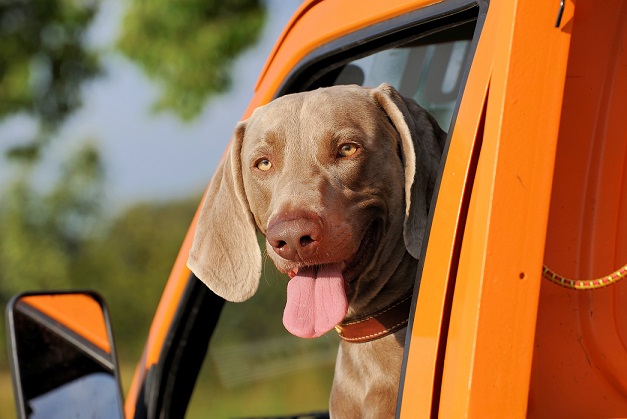How to Help Your Dog Get Used to Car Rides

Some of us take it for granted that our dogs are calm and content riding in the car. It is a stressful or scary experience for a lot of dogs, causing them to whine or bark the entire time or to become car sick.
The following are some tips to help your dog get used to the car or to make sure riding in the car remains a positive experience for your newly adopted dog or puppy.

Tips to help a dog get used to the car
1. Take your puppy on car rides right away
Don’t worry, it’s not too late if your dog is an adult. However, if you have a puppy, it’s a good idea to expose him to car rides early.
You could give your puppy a couple of small, yummy treats in the car (but only a few in case she gets car sick). I would also bring along a favorite toy and drive to places she would enjoy such as various nearby parks.
Dog trainer Patricia Bentz of K-9 Training & Behavior Therapy said to try to keep these first rides pleasant and fun for your pup.
2. Give your dog treats in the car without actually driving anywhere.
Bentz said to start out by encouraging your dog to lie down calmly in the car while you give him treats or a message without actually driving anywhere.
Then, over time you would gradually increase the time in the car and start to drive to nearby, fun places like a park or play area, she said.
3. Keep the rides short and positive.
Some dogs are scared or nervous riding in the car because of past negative experiences, Bentz said.
“The negative initial association with a car ride is enough to convince them that all rides are unpleasant,” she said.
According to her, some of those unpleasant experiences could include:
- Experiencing motion sickness in the past
- Getting bounced around on a rough ride
- Being left in the car too long
She also said that some dogs are just fearful of new things by nature and have trouble coping with new experiences.
4. Prevent motion sickness
Some dogs get motion sickness easier than others, but it helps if your dog does not have a full or a completely empty stomach, Bentz said. It’s also a good idea to avoid sudden, sharp turns.
If your dog experiences motion sickness, Bentz said to talk with your dog’s vet about options. On the other hand, if your dog pants heavily with no drooling or vomiting, she said to seek help from a behaviorist or certified dog behavior consultant to address your dog’s anxiety.
5. Use a crate or dog seatbelt
Some dogs will feel more comfortable riding in a crate. I actually have a cat that gets nervous on car rides, and he feels (and is) more secure when he rides in his cat carrier.
A dog seat belt can also help some dogs. Not only will a dog seatbelt keep your dog safer if you’re ever in an accident, but it will prevent a nervous dog from pacing around the car.
If the dog is unable to pace, he is more likely to settle in and remain sitting or lying down. He is also less of a distraction for the driver. dogIDs carries a couple of dog seat belt tethers to help keep your dog safely secured in the car.
Also, see our post on why dogs should be buckled up for safety.
6. Get your dog used to windshield wipers
Finally, Bentz added one more tip that is sometimes overlooked.
“Don’t forget to desensitize your dog to those scary, fast-moving windshield wipers that come on suddenly and unexpectedly,” she said.
Good point!
How does your dog do while riding in the car? Do you have any tips for new dog owners?
Explore Popular Articles
-
Homemade Flea, Tick & Mosquito Repellent for Dogs: A Natural Recipe for Pet Parents
Jun 13, 2025Beyond the Buzz and Itch: Protecting Your Pup from Mosquitoes, Fleas, and Ticks As pet parents, we w
-
Can My Dog Eat This? A List of Human Foods Dogs Can and Can't Eat
Jun 04, 2025As loving dog owners, we consider our furry companions members of the family. They share our homes,
-
How Long Are Dogs Pregnant - Tips for Care & Safety
May 15, 2025Congratulations! If you’re reading this, your furry friend is likely expecting a litter of pup




